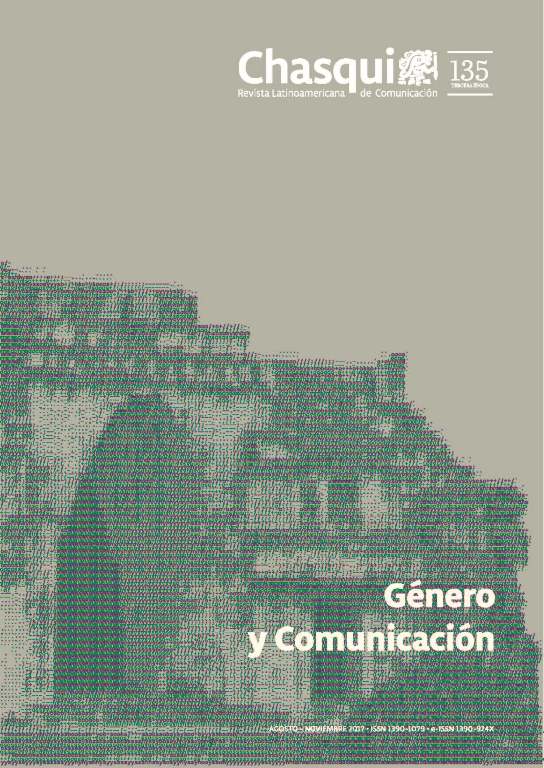To educate in audiovisual communication: a challenge for “updated” Cuba
DOI:
https://doi.org/10.16921/chasqui.v0i135.2752Keywords:
cultural consumption, media, empowerment, protectionism, televisionAbstract
This article discusses the relevance of an education in audiovisual communication in the current context of Cuba, when updating the economic and social model is a priority for the Government. The “selective isolation” that, for decades, allowed the exclusivity of an audiovisual offer centralized in the media, property of the State, suffered an onslaught in 2008, with the boom of the “package”. Through this informal alternative for the distribution of contents, people consume foreign made audiovisual products, amongst others, in hours of their own choosing. Official discourses and the press admit the changes in the audiovisual consumption patterns, but the Government´s strategy privileges alternatives to banality, instead of taking formal responsibilities for the empowerment of the citizenship.References
Acosta, M. & Costales, Z. (2012). La enseñanza audiovisual desde un enfoque inclusivo. Revista Electrónica de Investigación y Docencia, 8, 81-94. Disponible en http://bit.ly/2fdctBM.
Adorno, T. & Horkheimer, M. (1988). La industria cultural. Iluminismo como mistificación de masas. Buenos Aires: Editorial Sudamericana.
Aguaded, J.I. (1994). La educación para la comunicación. La enseñanza de los medios en el contexto iberoamericano. Comunicar, 3, 105-107.
Aguaded, J.I. (1998). Educación para la competencia televisiva. (Tesis doctoral, Universidad de Huelva). Recuperada de http://bit.ly/2v1aNR7.
Aznarez, J. (2015, 11 de junio). En la Cuba de hoy la gente ve las series y películas que quiere ver. El País. Disponible en http://bit.ly/2vunt3C.
Banco Mundial (2015). Usuarios de Internet (por cada 100 personas). Disponible en http://bit.ly/2v1nVpI.
Barreto, I. & Hernández, P. (2005). Hacia una pedagogía del audiovisual en la escuela: la experiencia cubana. La Habana: IPLAC.
Bernard, R.H. (2012). Social research methods: Qualitative and quantitative approaches. California: Sage.
Castells, M. (2003). Global Informational Capitalism. En D. Held & A. McGraw (comp.), The global transformations reader: an introduction to the globalization debate (331-334). Cambridge: Polity Press.
Concepción, J.R. (2015, 19 de octubre). Escaneando el Paquete Semanal (I) (+ Infografía). Cubadebate. Disponible en http://bit.ly/2vm4DMM.
Cubadebate (2016). ETECSA anuncia pruebas piloto para llevar internet a los hogares. Disponible en http://bit.ly/2hstGHZ.
Cubanet (2014). Misceláneas de Cuba: El Estado contra las antenas parabólicas. Disponible en http://bit.ly/2vuj0yc.
Delio, E. (2012). La televisión en la sociedad de la información. Reflexión Académica en Diseño y Comunicación, XIX, 198-203.
Desde La Habana (2011). Constructor de antenas parabólicas, oficio de riesgo en Cuba. Disponible en http://bit.ly/2vmDngW.
Domínguez, L. (2015, 31 de diciembre). 2015: año de la wifi en Cuba. Cubadebate. Disponible en http://bit.ly/2wqfFNN.
Empresa de Telecomunicaciones de Cuba S.A. (2015, 12 de noviembre). Nuevas zonas wifi para acceso a Internet. Granma. Disponible en http://bit.ly/2uoRVIf.
Ferres, J. (2006). La educación en comunicación audiovisual en la era digital. Quaderns del CAC, 25, 5-8. Disponible en http://bit.ly/2uoqwqa.
García Canclini, N. (1999). La globalización imaginada. Buenos Aires: Editorial Paidós.
Gómez Bugallo, S. (2014, 4 de abril). ¿Qué guardarías de Cuba en tu mochila?. Juventud Rebelde. Disponible en http://bit.ly/2vufO5z.
González, V.A. (2014, 10 de octubre). Mochila versus paquete, de la guerra a la asimilación. 14yMedio.com. Disponible en http://bit.ly/2wpTjM8.
Guevara, E. (1988). El socialismo y el hombre en Cuba. La Habana: Editora Política.
Islas, O. (2011). Los primeros años de internet en América Latina. Razón y Palabra, 76. Disponible en http://bit.ly/246cF2D.
Johnson, S. (2006). Everything Bad is Good for You: How Today's Popular Culture is Actually Making Us Smarter. New York: Penguin Group.
Joven Club (2015). Mi Mochila: Un paquete al estilo de Joven Club. Disponible en http://bit.ly/2v3oUE7.
Lloret, R. (2017). El penúltimo invento cubano: Netflix sin Internet. Disponible en http://bit.ly/2vmZROV.
Martínez, J. (2003). Una breve mirada a la historia de la internet cubana. Disponible en http://bit.ly/2fcXY0F.
Martínez-Salgado, C. (2012). El muestreo en investigación cualitativa. Principios básicos y algunas controversias. Ciência & Saúde Coletiva 17, 613-619.
Marrero, J. (1998). Dos siglos de periodismo en Cuba. La Habana: Editorial Pablo de la Torriente.
Masterman, L. (1993). The Media Education Revolution. Canadian Journal of Educational Communication, 1(22), 5-14.
Morales, G. (2015). Lo mejor del paquete. Disponible en http://bit.ly/2hrDWQJ.
Oliva, M. (2006). Panorámica de la educación en comunicación audiovisual. Quaderns del CAC, 25, 29-40. Disponible en http://bit.ly/2wq3Reb.
Pérez Betancourt, R. (2014, 18 de septiembre). Del paquete y otras visitaciones. Granma. Disponible en http://bit.ly/2wbssEl.
Pradas, T. (2006). Pisadas en pavimento fresco. Disponible en http://bit.ly/2vn1sV4.
Rivero, Y. (2008). Pensar la educación audiovisual infanto-juvenil en Cuba. Acercamiento desde sus experiencias. Perfiles de la Cultura Cubana, 01. Disponible en http://bit.ly/2u5h0Je.
Robles, O. (1999). Evolución de internet en América Latina y el Caribe. En Simposio Latinoamericano y del Caribe: las tecnologías de información en la sociedad. Aguascalientes, México (pp. 257-264).
Rodríguez, A. (2015). “Voces desde Cuba: El millonario negocio del peculiar internet cubano sin conexión a la red. Disponible en http://bbc.in/1UJSN0C.
Sánchez Navarro, J. (2006). Narrativa audiovisual. Barcelona: Editorial UOC.
Sánchez Serra, O. (2017, 3 de marzo). Por una hazaña, no una sorpresa. Granma. Disponible en http://bit.ly/2v1qKqF.
Suárez, M. (2013). Cuba: internet, acceso y sociedad del conocimiento. Razón y palabra, 81. Disponible en http://bit.ly/2u5SDuI.
Vicent, M. (2009, 30 de mayo). La guerra de las parabólicas en Cuba. El País. Disponible en http://bit.ly/2vucSWG.
Downloads
Published
Issue
Section
License
- Authors retain copyright and grant the journal right of first publication with the work simultaneously licensed under a Creative Commons Attribution-NoDerivs License (CC BY-ND) that allows others to share the work with an acknowledgement of the work's authorship and initial publication in this journal.
- Authors are able to enter into separate, additional contractual arrangements for the non-exclusive distribution of the journal's published version of the work (e.g., post it to an institutional repository or publish it in a book), with an acknowledgement of its initial publication in this journal.
- Authors are permitted and encouraged to post their work online.

